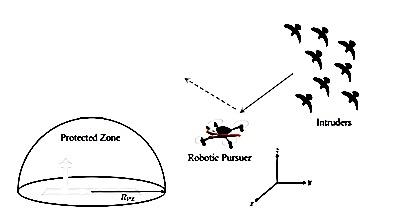With A New Algorithm, A Drone Can Autonomously Protect Airfields
Engineers at Caltech have developed a new control algorithm that enables a single drone to herd an entire flock of birds away from the airspace of an airport. The algorithm is presented in a study in IEEE Transactions on Robotics.

The project was inspired by the 2009 "Miracle on the Hudson," when US Airways Flight 1549 struck a flock of geese shortly after takeoff and pilots Chesley Sullenberger and Jeffrey Skiles were forced to land in the Hudson River off Manhattan.
"The passengers on Flight 1549 were only saved because the pilots were so skilled," says Soon-Jo Chung, an associate professor of aerospace and Bren Scholar in the Division of Engineering and Applied Science as well as a JPL research scientist, and the principal investigator on the drone herding project. "It made me think that next time might not have such a happy ending. So I started looking into ways to protect airspace from birds by leveraging my research areas in autonomy and robotics."
Current strategies for controlling airspace include modifying the surrounding environment to make it less attractive to birds, using trained falcons to scare flocks off, or even piloting a drone to scare the birds. These strategies can be costly or—in the case of the hand-piloted drone—unreliable, says Chung, who is a researcher at Caltech's Center for Autonomous Systems and Technologies.
"When herding birds away from an airspace, you have to be very careful in how you position your drone. If it's too far away, it won't move the flock. And if it gets too close, you risk scattering the flock and making it completely uncontrollable. That's difficult to do with a piloted drone," Chung said.
Herding relies on the ability to manage a flock as a single, contained entity—keeping it together while shifting its direction of travel. Each bird in a flock reacts to changes in the behavior of the birds nearest to it. Effective herding requires an external threat—in this case, the drone—to position itself in such a way that it encourages birds along the edge of a flock to make course changes that then affect the birds nearest to them, who affect birds farther into the flock, and so on, until the entire flock changes course. The positioning has to be precise, however: if the external threat gets too zealous and rushes at the flock, the birds will panic and act individually, not collectively.

In 2013, while he was an assistant professor at the University of Illinois at Urbana-Champaign, Chung received a National Science Foundation CAREER Award to tackle the problem. Originally, Chung intended to build a self-guided, flapping robot whose flight would mimic that of a falcon, figuring that the bioinspired design would make it even more effective at controlling flocks by presenting them with a natural-seeming threat. While the work in that direction did yield an entirely new style of drone—the "Bat Bot" that Chung unveiled in 2017—he found that an off-the-shelf quadrotor drone was just as effective at herding birds.
To teach the drone to herd autonomously, Chung and his colleagues, including Aditya Paranjape of Imperial College London, one of his former graduate students, studied and derived a mathematical model of flocking dynamics to describe how flocks build and maintain formations, how they respond to threats along the edge of the flock, and how they then communicate that threat through the flock. Their work improves on algorithms designed for herding sheep, which only needed to work in two dimensions, instead of three.
"We carefully studied flock dynamics and interaction between flocks and pursuers to develop a mathematically sound herding algorithm that ensures safe relocation of flocks using autonomous drones," says Kyunam Kim, postdoctoral scholar in aerospace at Caltech and a co-author of the IEEE paper.
Once they were able to generate a mathematical description of flocking behaviors, the researchers reverse engineered it to see exactly how approaching external threats would be responded to by flocks, and then used that information to create a new herding algorithm that produces ideal flight paths for incoming drones to move the flock away from a protected airspace without dispersing it.
"My previous research focused on spacecraft and drone swarms, which turned out to be surprisingly relevant for this project," Chung says.
The team tested the algorithm on a flock of birds near a field in Korea and found that a single drone could keep a flock of dozens of birds out of a designated airspace. The effectiveness of the algorithm is only limited by the number and size of the incoming birds, Chung says, adding that the team plans to explore ways to scale the project up for multiple drones dealing with multiple flocks.
The study, titled "Robotic Herding of a Flock of Birds Using an Unmanned Aerial Vehicle," was also co-authored by Hyunchul Shim from the Korea Advanced Institute of Science and Technology. Support for the research came from the National Science Foundation.
(Source: CalTech news release. Images from full report)
 ANN's Daily Aero-Term (04.24.24): Runway Lead-in Light System
ANN's Daily Aero-Term (04.24.24): Runway Lead-in Light System ANN's Daily Aero-Linx (04.24.24)
ANN's Daily Aero-Linx (04.24.24) Aero-FAQ: Dave Juwel's Aviation Marketing Stories -- ITBOA BNITBOB
Aero-FAQ: Dave Juwel's Aviation Marketing Stories -- ITBOA BNITBOB Classic Aero-TV: Best Seat in The House -- 'Inside' The AeroShell Aerobatic Team
Classic Aero-TV: Best Seat in The House -- 'Inside' The AeroShell Aerobatic Team Airborne Affordable Flyers 04.18.24: CarbonCub UL, Fisher, Affordable Flyer Expo
Airborne Affordable Flyers 04.18.24: CarbonCub UL, Fisher, Affordable Flyer Expo




